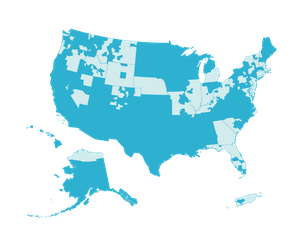Poverty is a public health crisis in rural America, where life expectancy is edging downward in low-income communities. Investing to energize rural places can upend this trend, writes Suzanne Anarde, who heads LISC’s rural program, in an op-ed for Huffington Post. But the time to act is now, before the preventable decline of our rural communities claims more lives.
The article below was originally published as:
"How can we heal what ails RURAL America?"
The Huffington Post
If you follow the news closely, it can seem like small-town America is in the throes of social and economic collapse. People are dying at alarming rates, and the common thread isn’t race or age or gender—it’s location. The challenges facing rural areas are quite literally a death sentence for thousands of people every year.
Data makes that clear. Nearly one in five rural counties is experiencing rising rates of premature death—even as residents of their urban counterparts enjoy longer, healthier lives, according to recent data from County Health Rankings, a collaboration between the Robert Wood Johnson Foundation and the University of Wisconsin Population Health Institute.
Ironically, better access to health care is not the answer—at least not by itself. Instead, it will take a sharper focus on the social determinants of health—good housing, schools, jobs, fresh food and recreational space—to shift the outlook. If we want to improve the health of individuals in rural areas, we need to improve the health of the places where they live.
This is not a new concept, of course. In recent years, there has been a growing awareness that poverty is a public health crisis—especially with the County Health Rankings data to quantify the issues. Creative local leaders have developed an array of innovative programs to respond to local need, and many have had extraordinary outcomes: Laid-off workers retool their skills to take advantage of emerging industries. Schools become economic and social drivers, helping kids get fresh food while they learn and helping farmers build new markets for their produce. Isolated seniors gain access to quality housing and health care, moving into developments that restore their neighborhood connections and add economic vibrancy to the surrounding area.

These programs help people live better—even if in small doses. And that is a part of the problem. It’s much harder to achieve scale in geographically dispersed communities than it is in dense urban areas, even when many of the underlying challenges are the same. How do we make sure rural families can find new opportunities to flourish in the same way that urban families benefit from concentrated programs focused on housing, health, businesses and safety?
Local leaders from 1,400 rural counties are coming together this week in Washington, D.C., to address that very dilemma by diving into data and sharing ideas that can be replicated to benefit a spectrum of residents. Rural LISC has organized the conference to spur more of this work in small towns across the country.
So what are the programs we’ve seen succeed? In Ventura County, Calif., for instance, Cabrillo Economic Development Corporation is rehabilitating deteriorated rental housing and incorporating a range of healthy building practices as part of the effort. That includes green space, community gardens and recreational areas, like bike paths. It means focusing on indoor air quality to reduce asthma and even offering nutrition education for residents.

In Big Sky country, along a three-county area of Montana north of Yellowstone Park, a nonprofit community development group called the Human Resource Development Council is integrating a focus on health into many of its programs, working with professionals at a local emergency room to provide housing for homeless patients; offering home care for seniors so they can age in place; and incorporating nutrition and family services into its Head Start offerings.
And in Marvell, Ark., about halfway between Little Rock and Memphis, an organization called Boys, Girls, Adults (BGA) Community Development Center is using food to reach residents in need. It operates a greenhouse and community garden that grow produce for people who can’t otherwise afford it. Leafy greens, tomatoes, beans and onions are cooked into delicious meals at BGA’s “Best Food in Town” restaurant, which also provides jobs in this small community. Children learn about nutrition and agriculture at classes in the gardens.
Proven programs like these are replicable. They address health as part of broader efforts to alleviate poverty and can be part of systemic solutions to improve the quality of life in rural America.
This is really a question of choices. Will we choose to act—to expand and fund programs that have proven their worth—or will the status quo prevail? If we do nothing, rural residents will continue to die too young and our rural communities will continue to decline. That’s simply unacceptable.
 ABOUT THE AUTHOR
ABOUT THE AUTHOR
Suzanne Anarde, Program Vice President for Rural LISC
Suzanne has served as program vice president for Rural LISC since 2013. Drawing on her more than 25 years of experience in the field, she leads a team that provides financial support, training and technical assistance to help community developers address the unique challenges of rural revitalization.
Video: A Conversation About Rural America
When Rural America thrives, America thrives. That's what Lisa Mensah, Under Secretary of USDA Rural Development and Suzanne Anarde, Vice President of Rural LISC, say in their conversation about why it's important to help distressed Rural communities.
Read more about LISC's work in rural communities:
